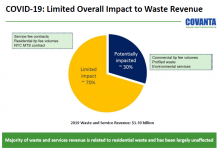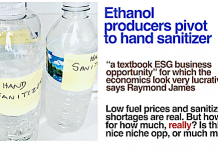The Future is Cellulosic
It is now widely accepted that the future of ethanol is cellulosic: Rather than distilling corn for ethanol to fuel our cars, accepted wisdom is now that we will be able to replace a large fraction of our current fuel consumption with ethanol distilled from agricultural and forestry waste, as well as dedicated energy crops, such as switchgrass and hybrid poplar. Cellulosic ethanol also has the potential to alleviate the greatest stumbling block of corn ethanol as a potential replacement of gasoline: that there is simply not enough of it. Corn ethanol will only be able to displace a small percentage of total US gas consumption. If the entire current US corn crop were converted into ethanol, it could replace less than 20% of current gasoline consumption. More realistically, the National Renewable Energy Laboratory (NREL) projects that 4% of gasoline could be replaced without overly affecting corn prices.
Recently, cellulosic ethanol has been much in the news. POET recently announced that they were producing cellulosic ethanol from corn cobs and the fiber in corn kernels, while FPL Energy LLC signed a deal with Citrus Energy to develop a biorefinery to make ethanol from citrus waste. Both of these plants avoid one of the biggest hurdles that cellulosic ethanol still has to overcome: the distributed and varied nature of potential cellulosic feedstocks. POET will be working with waste that would otherwise have to be disposed of, while the FPL/Citrus Energy plant uses a citrus processing waste which "is available at the plant at no cost [and] with no transportation costs."
In addition to cellulosic’s transportation Achilles Heel, these two projects also show how far we are from tackling the true scale of the problem: POET’s plant will deliver 27% more ethanol from an acre of corn, while the "ethanol from citrus peel could… replace about 1% of Florida’s gasoline production." So if these two technologies were to be scaled up to use the entire US corn crop and all available citrus processing waste, we still could replace less than 6% of US gasoline usage with ethanol from these sources.

The Size of the Problem. Source: National Renewable Energy Laboratory
The limited supply of agricultural and forestry waste is why cellulosic visionaries often look farther a field, to other sources of agricultural waste in addition to corn cobs and citrus, as well as to dedicated energy crops. NREL estimates that while we can produce about 0.3 billion barrels (oil equivalent) of ethanol from corn, the biochemical conversion of inedible carbohydrate would be able to supply 1.1 billion barrels of oil equivalent, or about 17% of current oil consumption.
Using Non-food crops
This leads inevitably to talk of switchgrass, and other "energy crops." If land which is not currently considered suitable for conventional agriculture can be used to produce high-energy content feedstock for our ethanol plants, we will have a source of supply of fuel for our vehicles that does not impinge on our food supply. One much discussed option is using Conservation Reserve Parcel (CRP) land to grow highly productive perennial grasses such as switchgrass and miscanthus. While miscanthus seems to be more productive than switchgrass, switchgrass has the benefit of incumbency: many of the existing CRP parcels are already planted with swithgrass, a North American native. Another contender is a diverse mix of native prairie plants, which has more than twice the energy yield of any native monoculture.
Before we can move to a system of growing energy crops, and transporting those crops to cellulosic ethanol plants, we first have to find a process of breaking down cellulose into something that can be easily fermented into fuel. We can already accomplish this, but the sticking point remains cost.

DOE Cellulosic cost goals. When I first saw this slide, I asked an NREL spokesman why they assume that the price of feed will drop to $34 per ton. He replied that they had to in order to achieve DOE’s cost targets.
There has been considerable progress in reducing the cost of conversion and enzymes. One interesting pathway being explored is to adapt natural systems, such as enzymes from the guts of termites, or to use fungi to help break down resistant cellulosic material.
Let Cows Eat Grass
Cows evolved to eat grass, including proposed energy crops such as switchgrass, which is already used as forage for livestock, and the more productive mixed prairie plants (including grasses.) We don’t have to wait until the technology for converting grass into ethanol becomes economic to use grass to increase ethanol production: Instead, all we need to do is to supply the grass to the cattle, and use the corn that they would have eaten instead to produce ethanol.
Feedlot operators will doubtless protest at the massive logistical problems of bringing hay, rather than corn, to feedlots where cattle are fattened. However, these logistical problems seem to me to be on the same order of magnitude as supplying that same grass to cellulosic ethanol plants, if it is too much to ask of the cattle industry to let the cattle "harvest" the grass themselves by grazing.
How much ethanol could we gain by shifting cattle feed to ethanol production? In the 2005/6 season, 6.1 billion bushels of corn was used for animal feed, about 1.8 billion bushels of which went to feed cattle, compared to 1.6 billion bushels used to make ethanol. Hence, we could double ethanol production by using corn currently fed to cattle. And, since distiller’s grains, a byproduct of ethanol production is usually fed to cattle, not all of the current feed corn would have to be replaced with hay to do so.
In addition to the logistical problems of getting hay to feedlots, beef producers have other objections to "finishing" cattle on grass. First, corn-fed cattle can be fattened much more quickly than grass fed cattle (by as much as a year.) In addition, corn feeding produces a juicer steak with more marbling than grass feeding. Offsetting these advantages of grain fed cattle are the health advantages of grass fed cattle. Grass fed cattle have much higher concentrations of CLA and Omega-3 fatty acids. While the health benefits of CLA have only been demonstrated in animals to date, the American Heart Association says Omega-3 fatty acids benefit the heart of healthy people, and those at high risk of or who have cardiovascular disease. These are the fatty acids for which wild fish are prized, and which some believe may be able to cure a wide variety of ills.
Finally, the same arguments that are made against corn based ethanol apply equally well to corn-fed beef, because they are essentially arguments against using corn, rather than against making ethanol. For instance, the fossil energy used to grow corn is the same, regardless of use, and so this fossil energy is consumed equally if it goes into our cars or into our cows. I have not done the calculations, but I expect that much of the benefit in terms of our personal carbon footprint which might be gained by giving up beef altogether might also be gained by eating grass-fed beef. According to a recent Japanese study, over two-thirds of the energy in beef production goes towards producing and transporting the animals’ feed. Just as the feedstock for ethanol has a large effect on its energy balance, so does the feed of the cattle we eat.
There may be other benefits as well, such as fewer dangerous E-Coli outbreaks. The strain of E-Coli which put most of us off spinach last year only grows in the guts of grain-fed cattle, not grass fed ones.
How it Might Happen
Rising corn prices are already making it less economical to feed corn to cattle. Clearly, we are not going to see 1.8 billion bushels of corn a year diverted from cattle feed to ethanol overnight, but the changing economics are likely already having an effect. As it becomes more expensive to feed cattle, a rational owner will look for alternatives, and grass will surely be one of these alternatives. Over time, I expect to see cattle spending more of their lives grazing, and less at the feedlot. I would not be surprised if this trend has already begun, and recent statistics show that new cattle placed in feedlots are down 15% from 2006 and 6% from 2005 for the month of June.
Over the longer term, some feedlots and dairies will close as they are used less intensively, while others will shift to feeds which contain more distiller’s grains and, eventually, hay. Other potential substitutes for corn in feed include some of the other options which are being considered for cellulosic ethanol, such as corn cobs (which have long been fed to cattle) and stover. All this will come at the price of more expensive beef and milk, but it will be less expensive than it would have been if methods remained unchanged, as well as healthier to eat. We will probably eat less beef overall, and be healthier for it.
Investments
Companies hoping to use grasses as a feedstock for cellulosic ethanol plants may find themselves in unexpected competition with cattle, and so excitement around companies such as BlueFire Ethanol Inc. (OTCPK: BFRE) may be overblown. However, to the extent that they plan to use feedstock which cannot be fed to cattle, a shift in cattle feeding should not effect them much. BlueFire is currently focusing on urban landfill waste, something I hope no one is contemplating feeding to cows. I do not know of any public companies that are currently focusing on grasses as a feedstock.
Conversely, the opportunity to double the amount of corn available to ethanol production may confound analysts who expect the ethanol boom to end due to rising corn prices. I admit that I have also worried publicly about a commodity squeeze in corn (here and here). Considering the recent gloom about ethanol producers due to rising corn prices, now may be a good time to make a contrarian bet on conventional ethanol producers such as Archers Daniels Midland (ADM), Green Plains Renewable Energy, Inc. (Nasdaq: GPRE), US BioEnergy Corporation (NASDAQ:USBE), VeraSun Energy Corp (NYSE: VSE), and Pacific Ethanol (PEIX).
Corn ethanol is certainly not going to bring the United States anywhere near energy independence, and it does little or nothing for the fight against global warming. It has, however, provided a relatively harmless use for the massive glut of corn created by US agricultural policy, at least in comparison to feeding ever greater amounts of corn to cattle and high-fructose corn syrup to humans.
DISCLOSURE: Tom Konrad and/or his clients have positions in the following stocks mentioned here: ADM.
DISCLAIMER: The information and trades provided here are for informational purposes only and are not a solicitation to buy or sell any of these securities. Investing involves substantial risk and you should evaluate your own risk levels before you make any investment. Past results are not an indication of future performance. Please take the time to read the full disclaimer here.









We are already seeing hay prices rise dramatically, too. So feeding cattle and other livestock is going to continue to get more and more expensive if there continues to be competition for cropland, whether that land is growing corn or grass or anything else. If our land base is going to be used to produce energy as well as food, we must come up with some way of growing more nutrient- and/or energy-rich feed per acre of land. Algae??
Thanks for the thoughtful comment, Lisanne. I had not thought to look at changes in hay prices, but it should be no surprise that they are rising.
Fortunately, we are not constrained by the same land supply for grass as we are for corn. A study by David Tilman of the University of Minnesota on mixed prairie grasses was specifically done on marginal land that is unsuitable for corn, but well suited to growing grass. And, while growing corn degrades the soil, proper grazing improves it, resulting in long term better productivity and some sequestration of carbon.
Hence, mixed prairie plants not only hold out the hope of higher energy yield, but they can also provide the expansion of crop land. However, this can not be done overnight. These are perennial plants, and they often take more than a year to mature to full productivity.
The rise in the price of hay is necessary to send the signal to farmers and ranchers that it is worth doing.
I believe that algae will eventually be part of the solution, but since that requires technical innovation, it will lag the increased use of grass. Efficiency will of course also be a large part of the solution. We can eat less and better quality meat, and less high fructose corn syrup, as well as drive more efficient vehicles or even walk occasionally. It will be along, drawn out process, but the higher food prices we’re seeing now have the potential to make Americans healthier, which would be a good thin in and of itself.
As far as cows go, in my large animals occupations program we fed our cows alfalfa and a grain mixture that resembled granola. American cows are known for being huge, a cow raised on grass alone would be thin and unhealthy. As far as gas, I think we should build some nuclear power plants and mass produce hydrogen fuel. There’s a global food shortage going on right now, lets stop this biofoolery and start thinking of the general welfare.